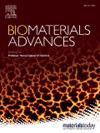用于骨修复和骨肉瘤治疗的可生物降解材料综述:从大块到支架
IF 6
2区 医学
Q2 MATERIALS SCIENCE, BIOMATERIALS
Materials Science & Engineering C-Materials for Biological Applications
Pub Date : 2025-04-11
DOI:10.1016/j.bioadv.2025.214317
引用次数: 0
摘要
骨肉瘤是影响青少年和儿童骨骼生长的最常见的恶性骨肿瘤类型,已成为医学科学的重大挑战。几十年来,化疗和手术相结合一直是标准的治疗策略。然而,对肿瘤复发的担忧和药物的毒性作用继续推动材料科学家开发多功能支架,同时支持骨再生和防止肿瘤复发。紧急多功能支架具有促进基本和动态细胞通信的潜力,可以直接靶向,信号,刺激和增强人体的自然骨修复反应。这篇综述强调了所涉及的机制,并强调了与这些支架有效促进骨修复能力相一致的各种技术和制造工艺,特别是在骨肉瘤存在时。此外,本文还对镁(Mg)、锌(Zn)和铁(Fe)基支架及其腐蚀产物的抗肿瘤性能进行了综述。本文还讨论了镁基、锌基和铁基材料在抑制骨肉瘤细胞增殖方面的治疗潜力。本文阐述了生物降解材料用于骨修复和骨肉瘤治疗的主要研究挑战和前景。本文章由计算机程序翻译,如有差异,请以英文原文为准。
Overview of biodegradable materials for bone repair and osteosarcoma treatment: From bulk to scaffolds
Osteosarcoma, the most common type of malignant bone tumor that affects growing bones in teenagers and children, has become a significant challenge for medical science. The combination of chemotherapy and surgery has been the standard treatment strategy for decades. However, concerns about tumor recurrence and the toxic effects of the drugs continue to drive materials scientists to develop multifunctional scaffolds that can simultaneously support bone regeneration and prevent tumor recurrence. Emergent multifunctional scaffolds have the potential to foster essential and dynamic cellular communication, which can directly target, signal, stimulate, and enhance the body's natural bone repair response. This review emphasizes the mechanisms involved and highlights various technologies and manufacturing processes that align with the capability of these scaffolds to effectively promote bone repair, especially in the presence of osteosarcoma. Additionally, the review summarizes the current state of knowledge regarding scaffolds based on magnesium (Mg), zinc (Zn), and iron (Fe), as well as the antitumor properties of their corrosion products. The review also discusses the therapeutic potential of Mg-, Zn-, and Fe-based materials in inhibiting osteosarcoma cell proliferation. The article elaborates on the main research challenges and prospects of biodegradable materials for bone repair and osteosarcoma treatment.
求助全文
通过发布文献求助,成功后即可免费获取论文全文。
去求助
来源期刊
CiteScore
17.80
自引率
0.00%
发文量
501
审稿时长
27 days
期刊介绍:
Biomaterials Advances, previously known as Materials Science and Engineering: C-Materials for Biological Applications (P-ISSN: 0928-4931, E-ISSN: 1873-0191). Includes topics at the interface of the biomedical sciences and materials engineering. These topics include:
• Bioinspired and biomimetic materials for medical applications
• Materials of biological origin for medical applications
• Materials for "active" medical applications
• Self-assembling and self-healing materials for medical applications
• "Smart" (i.e., stimulus-response) materials for medical applications
• Ceramic, metallic, polymeric, and composite materials for medical applications
• Materials for in vivo sensing
• Materials for in vivo imaging
• Materials for delivery of pharmacologic agents and vaccines
• Novel approaches for characterizing and modeling materials for medical applications
Manuscripts on biological topics without a materials science component, or manuscripts on materials science without biological applications, will not be considered for publication in Materials Science and Engineering C. New submissions are first assessed for language, scope and originality (plagiarism check) and can be desk rejected before review if they need English language improvements, are out of scope or present excessive duplication with published sources.
Biomaterials Advances sits within Elsevier''s biomaterials science portfolio alongside Biomaterials, Materials Today Bio and Biomaterials and Biosystems. As part of the broader Materials Today family, Biomaterials Advances offers authors rigorous peer review, rapid decisions, and high visibility. We look forward to receiving your submissions!

 求助内容:
求助内容: 应助结果提醒方式:
应助结果提醒方式:


